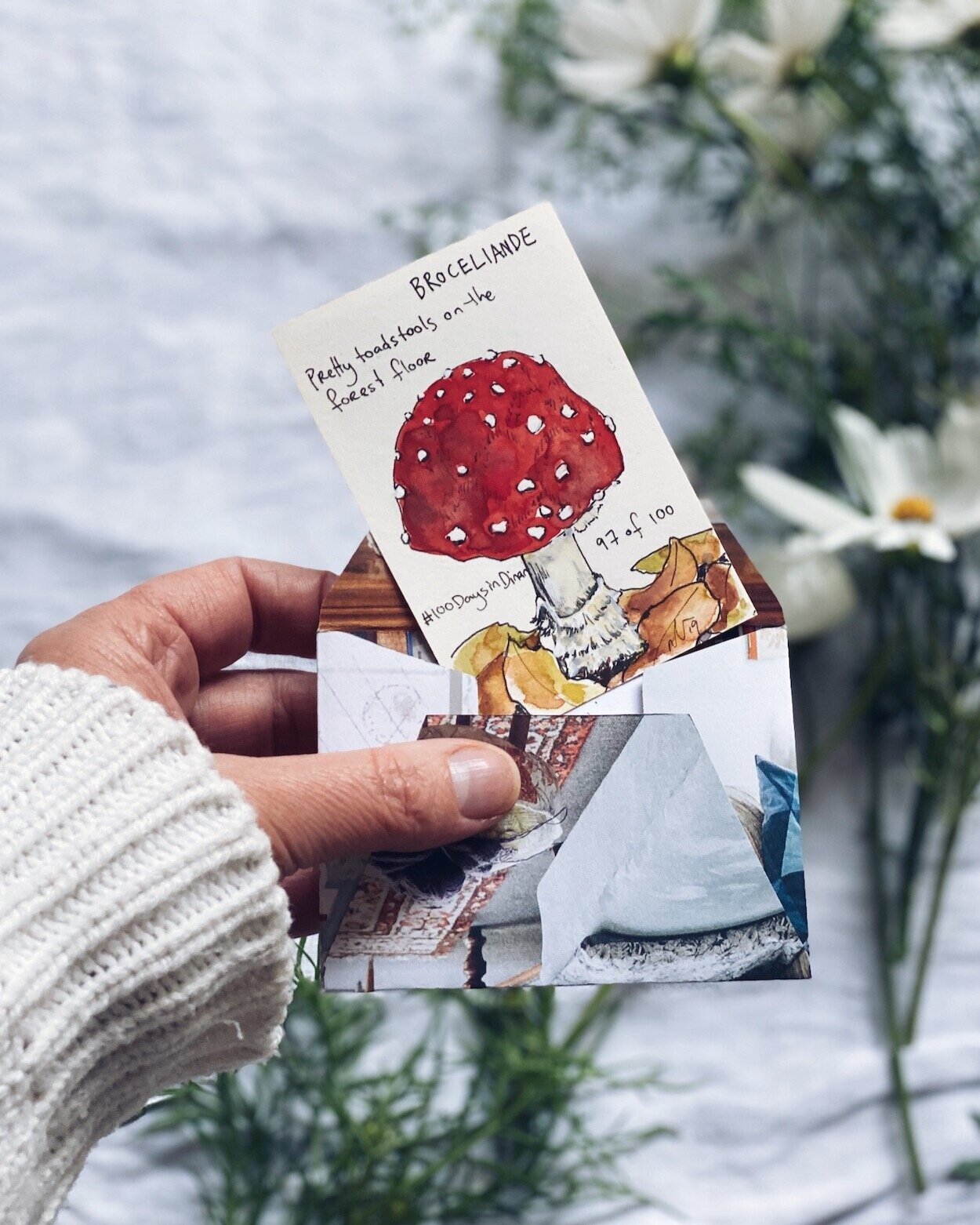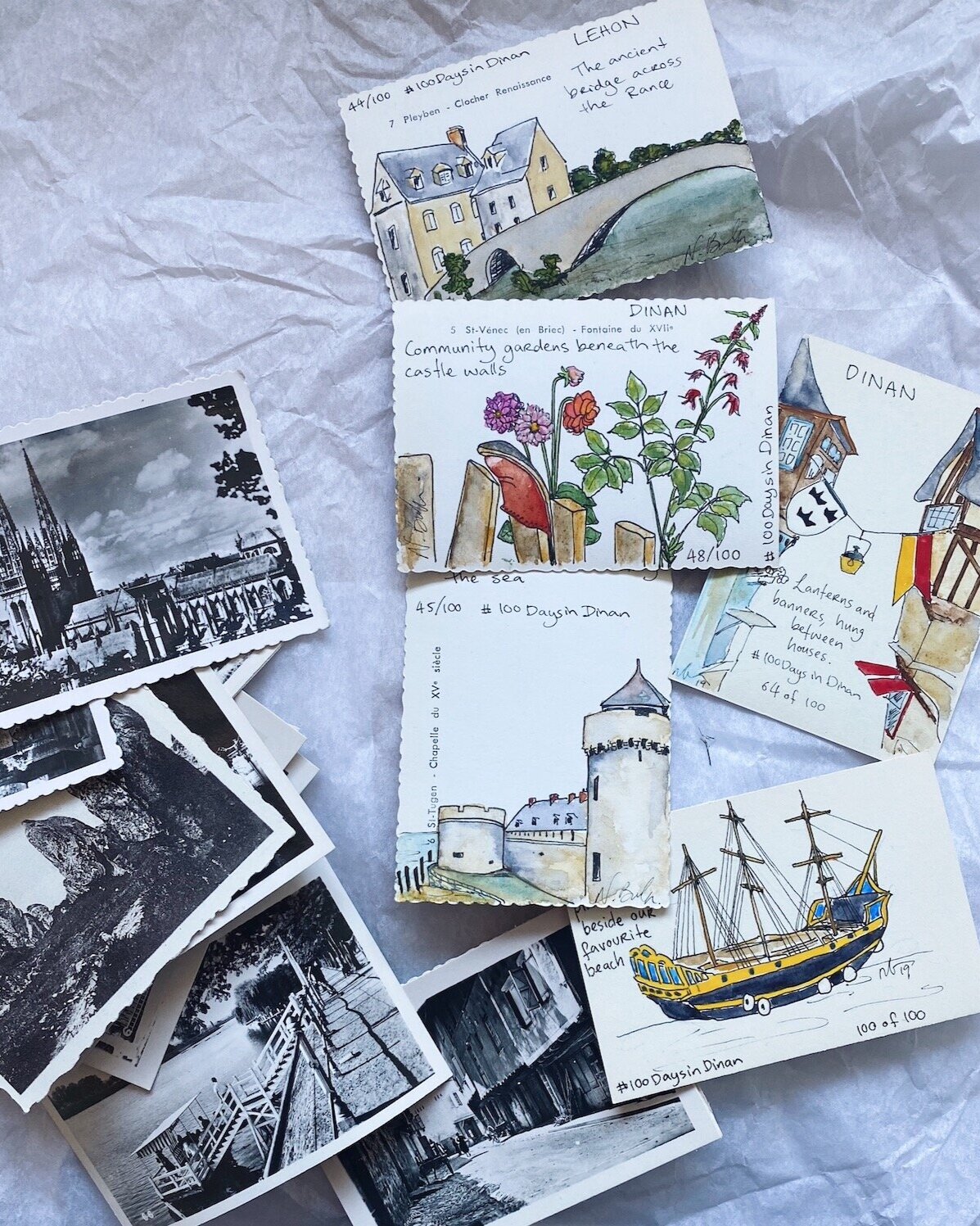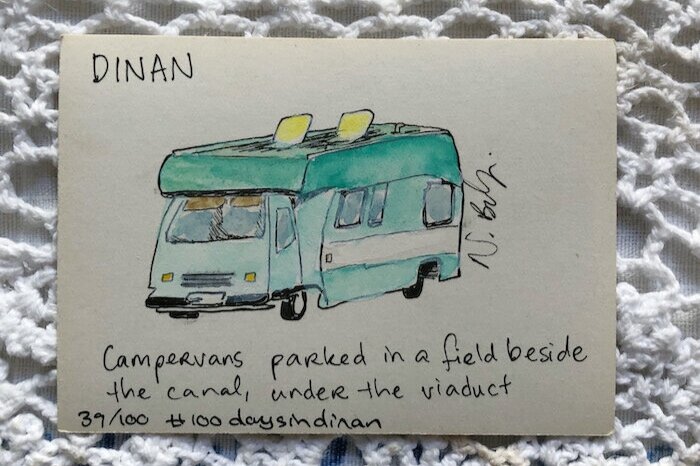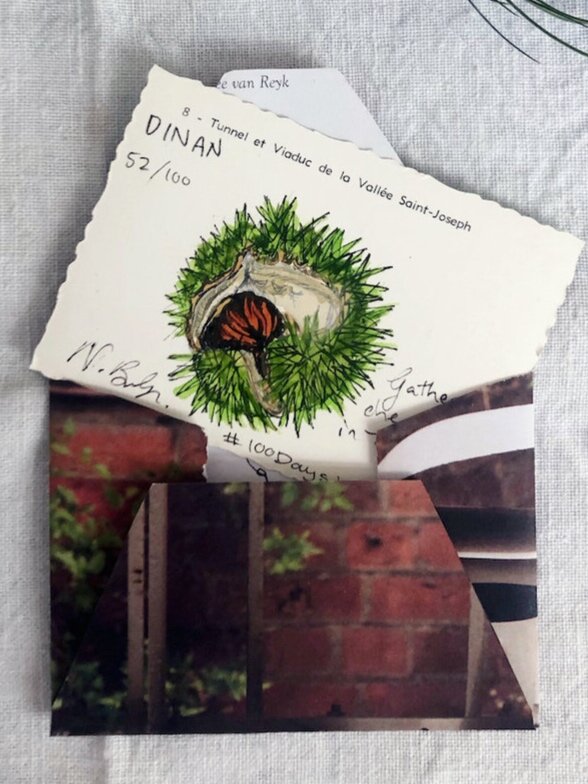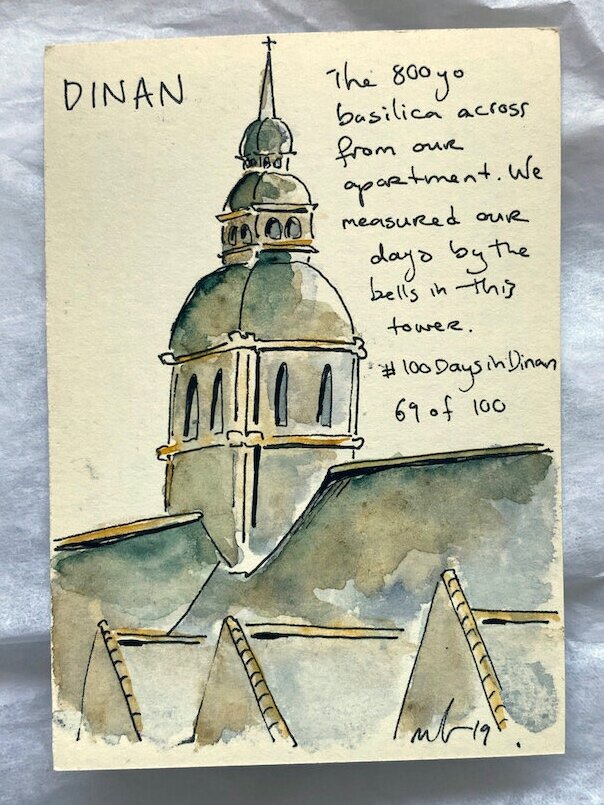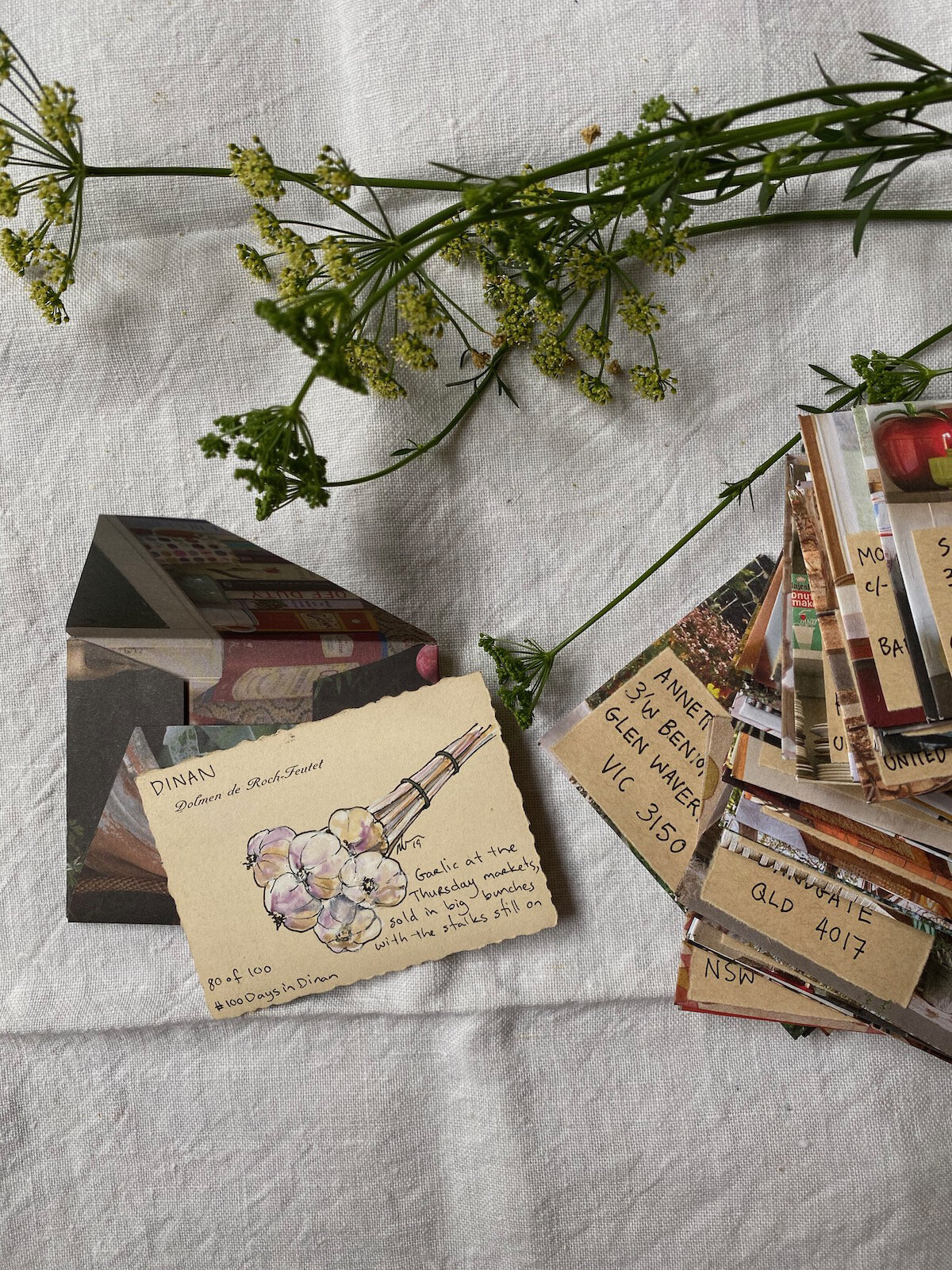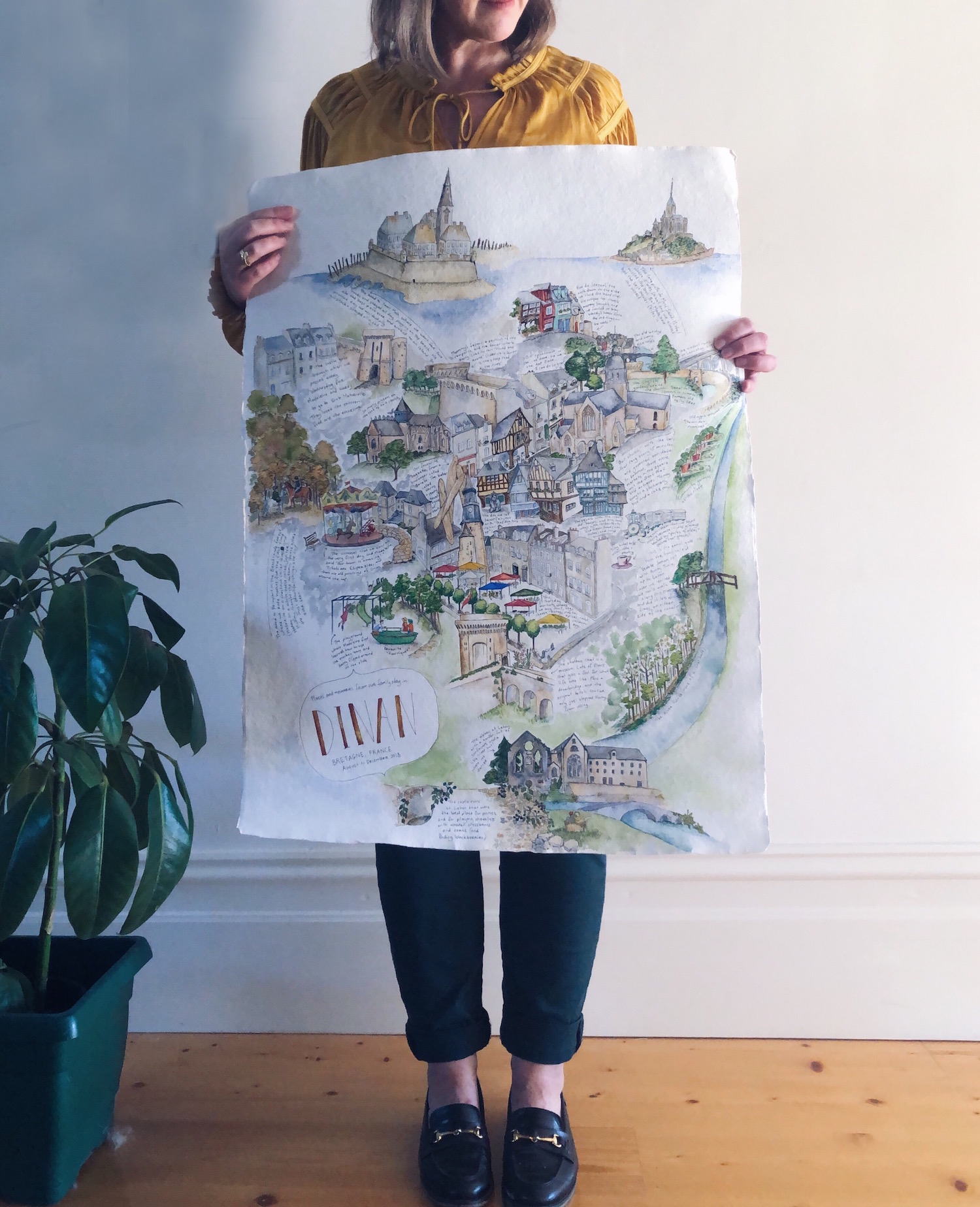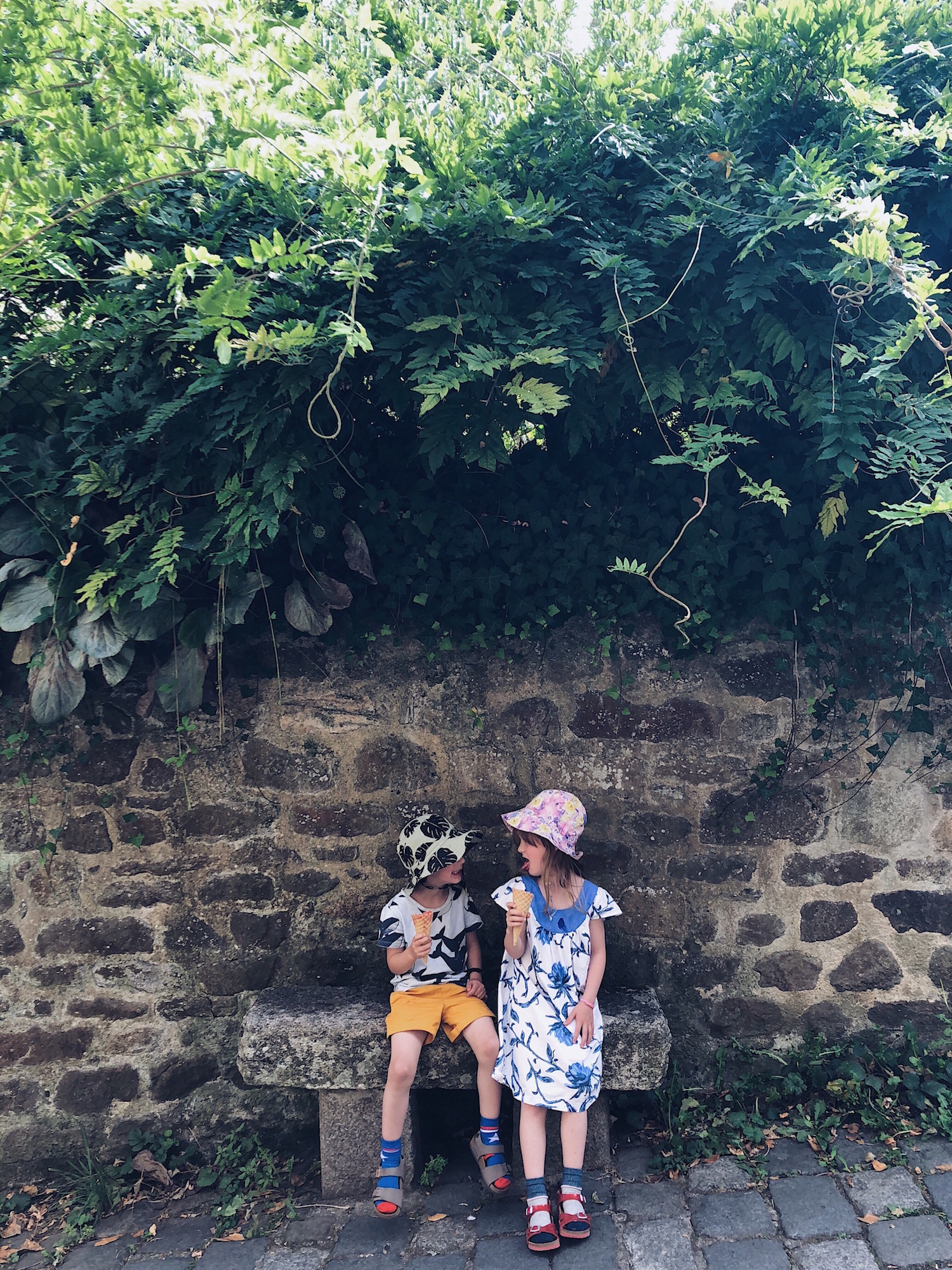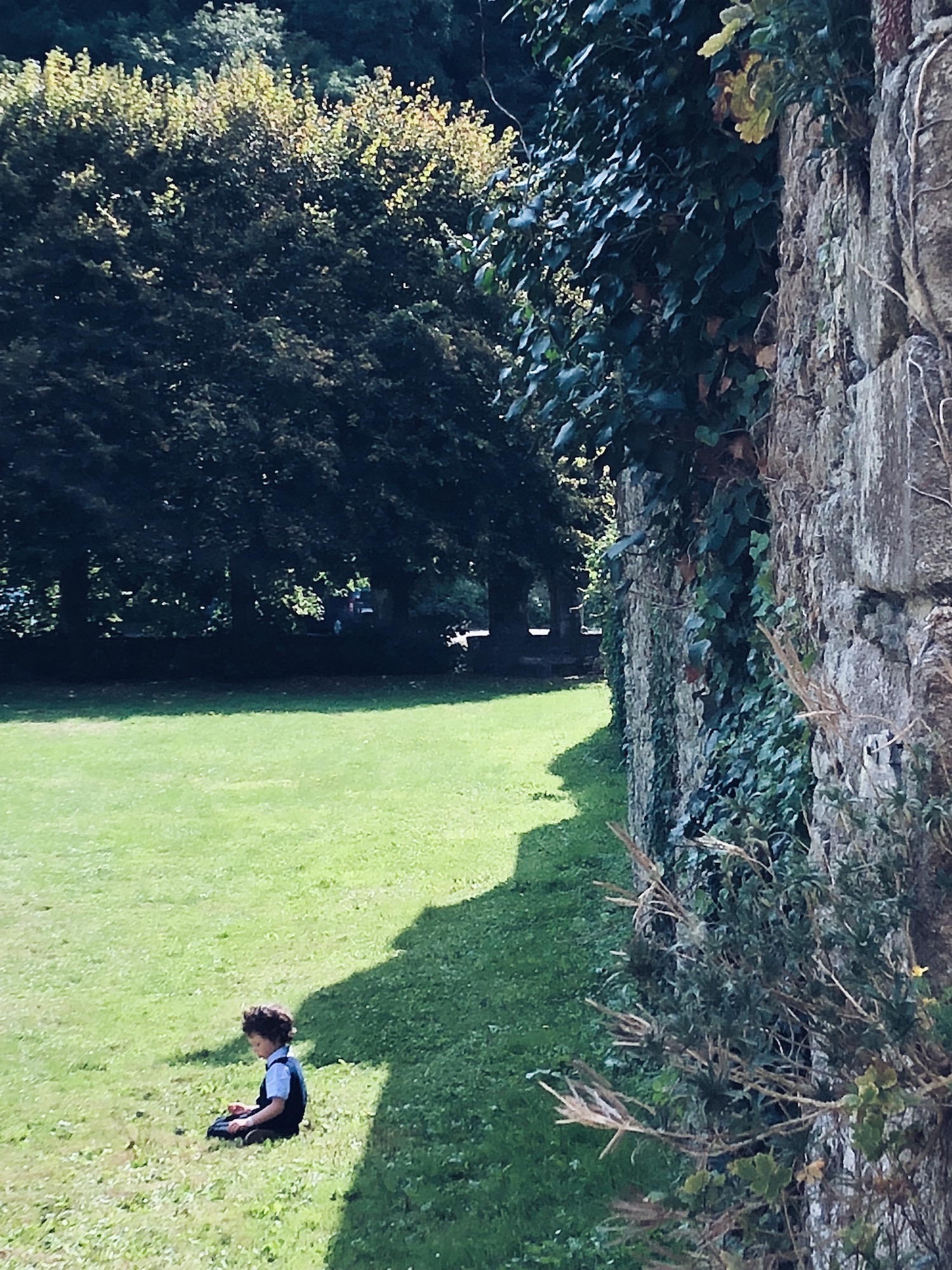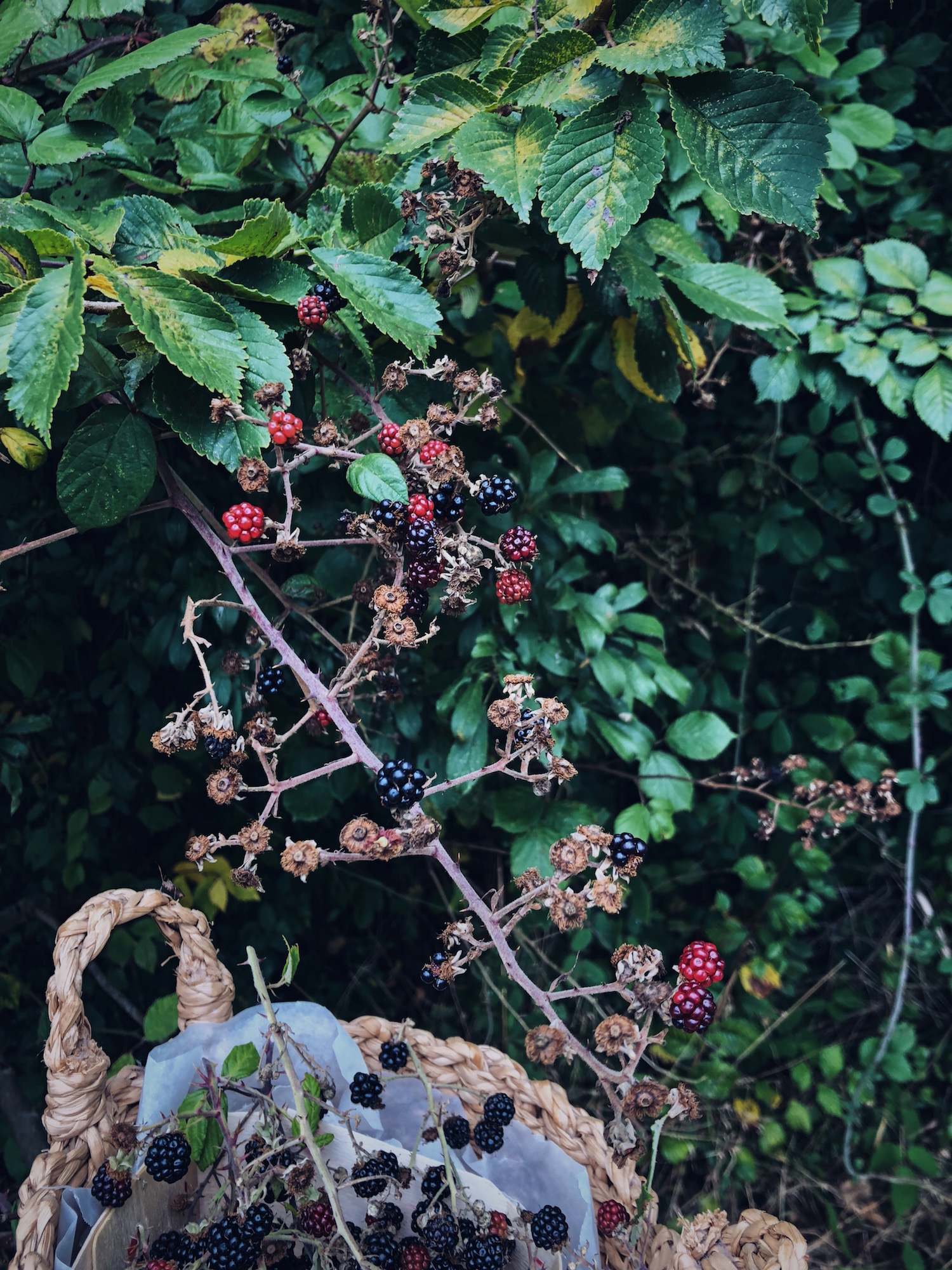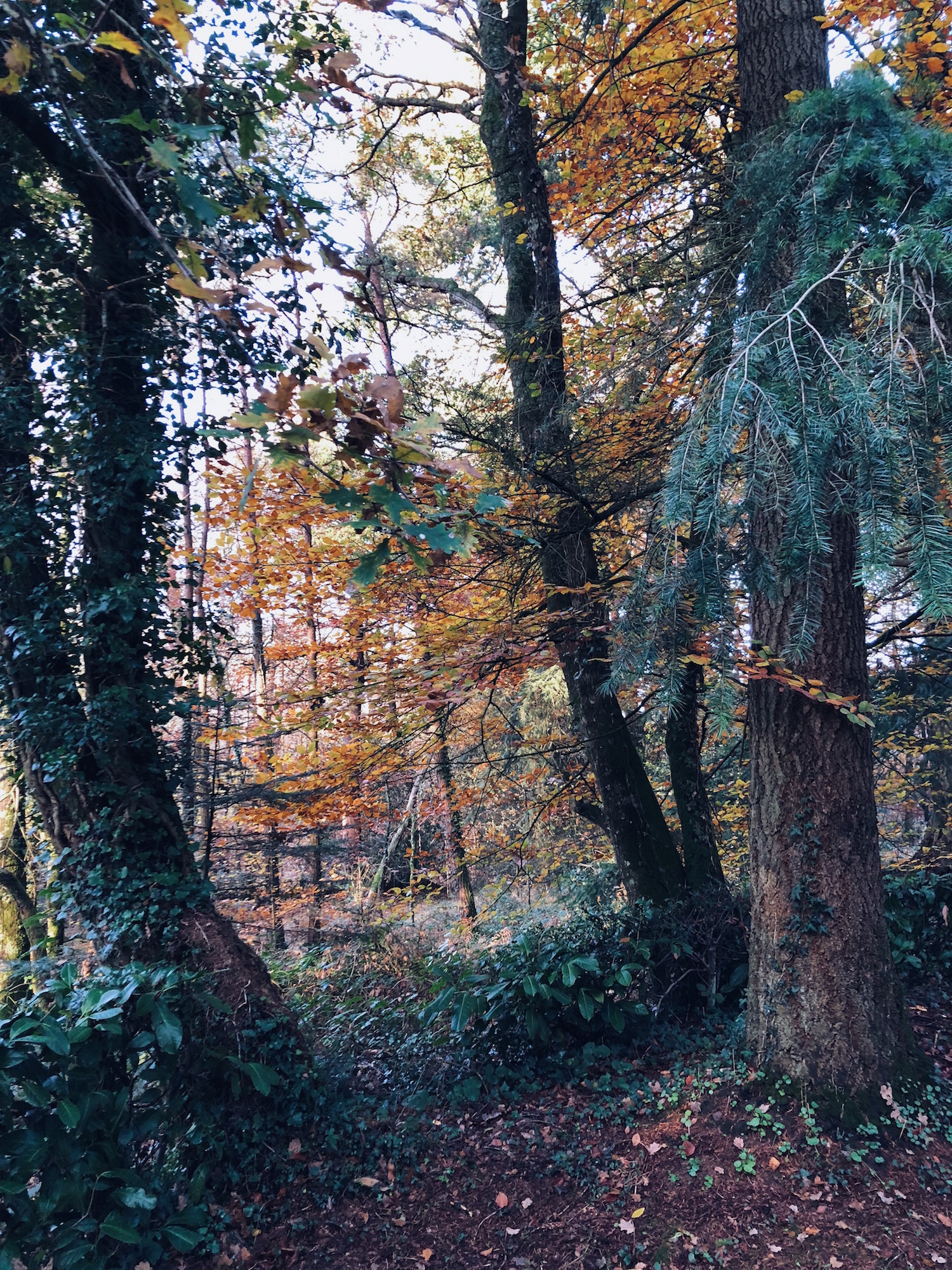
JOURNAL
documenting
&
discovering joyful things
A body of work
I called this project #100DaysInDinan. One hundred days can feel as fleeting as a week if you happen to be on sabbatical in a medieval French village with your two children. One hundred days pass in the blink of an eye as you watch those children grow (why are their pants too short again? weren’t they in nappies just yesterday?). Although I’m sure you’ll agree one hundred days can stretch out like a lifetime during lockdown.
When I set myself the challenge of illustrating and posting a miniature postcard every day for a hundred days, I hoped to celebrate the memories of our hundred days in France and make them last a little longer. I also wanted to see if I could establish some kind of creative habit that would last me beyond the project.
In the former, I was very successful. Each miniature illustration took me back to a place, a moment, or a conversation: tiny touchstones that helped to keep me connected with those halcyon days. But in the latter, I have to say I was an abject failure. I still wholeheartedly subscribe to the premise of “doing something creative for 20 minutes a day,” which is where I was going when I set myself this challenge. But the reality is that it took me a lot more than 20 minutes - sometimes several hours - to plan out, draw, paint, annotate and sign each postcard, then trace, cut out and paste together a mini envelope, then look up the next person’s address on my list of a hundred addresses and carefully write their address onto a tiny piece of paper and glue it to the envelope, then look up the postage cost online for the destination country and find the right stamps, then affix a wax seal to the back…
Frequently I struggle to find 20 minutes in my day so multiple hours was just too big an ask. That, and of course I’d have to pack away all my paints and papers every time anyone wanted to eat at the dining table (unreasonable family!), only to bring them all out and set up again the next time I wanted to paint. The reality then of my “one painting a day” project was that I’d knock out seven or eight in a weekend by doing nothing else, and then not get to the rest for another month or two. And so time passed.
I sent the last of the postcards to their new homes during Melbourne’s second lockdown, more than a year after I’d started my “100 days” project. The postal services being what they are at the moment, some of them are even taking 100 days or more to complete their journeys across the world. But I kind of like that. It’s fitting, in its own way, that a project that meant so much to me and was such an unexpectedly enormous labour of love would then take its own sweet time to complete the journey. After all, the postcards I was using were 100 years old or more: they had waited a century to be posted, there was no need to rush to the finish line.
And yet as I slipped the final 12 postcards into the red letterbox outside the post office, I did so with a distinct feeling of underwhelm. All that time. All that work! All those precious memories. All those oceans for my postcards to cross. And I was left with… nothing. Just the empty cardboard packets in which the postcards had been stored, locked away for a hundred years or more in somebody’s drawer.
It occurred to me too late that I had actually created for myself a “body of work.” But by posting them all away one by one, I hadn’t let the pleasant weight of creating that work actually settle.
I had been mindfully in the moment, painting each postcard one at a time, reliving the memory it evoked. But moments in life, while individually precious, are also cumulative, each of them drawing on those that came before and forming the scaffold for those that are yet come. (If you look at it this way, a life is a body of work. Or many bodies of work, to be more accurate.)
My miniature paintings were each part of a larger work, tiles in a mosaic, and while I wasn’t necessarily thinking about them in this way as I painted, the idea must have been there somewhere in my subconscious because instinctively I numbered each of them, solidifying their individual places within the one-hundred. They were never meant to exist on their own, and I learned that truth too late. If I had my time again I’d hold the postcards back, painting them all and then viewing them together to see what kinds of stories they told, before posting them back out into the world.
So now, for you but if I’m honest mostly for myself, I am going to retrospectively survey my body of work.
By pulling all 100 illustrated postcards together in this gigantic blog post, using iPhone photographs I snapped before posting (sometimes quite hastily), I have tried to piece together what this body of work might have been. Doing it this way has felt a little bit like an archaeological dig through my memories, once again painstakingly focusing on each individual item, not seeing the big picture until it is finally done, then standing up at last, stretching my back, and surveying the landscape uncovered.
Here it is, my body of work. A hundred days in the living, a year and a half in the making, and for these postcards, a century in the waiting. I wonder what stories it has to tell, when all the pieces are connected together like this? What does it say to me? Where does it take you?
If I learn the answer I’ll let you know.
The time spent navigating memories
It’s a slow process. I don’t just mean the making of the #100DaysInDinan project: combing through old photographs for inspiration, sketching a rough idea onto my antique postcards, going over it in pen, painting it. Then finding old pages from magazines, tracing onto them around the envelopes that had held the postcards for a century, folding them into place, then copying addresses onto paper and pasting them onto the front of the envelopes…
All this takes time, and perhaps in retrospect one a day was too ambitious.
But the real time is spent navigating memories. As I paint I walk my memories like I walked those old, cobblestoned streets, a hundred times over, during the 100 days we lived in Dinan.
As I sketch the outline of a fresh baguette, I am back there again, standing outside Boulangerie Banette with my children, tearing the still-warm loaf into into smaller pieces to share, and the smell is the best in the world: nutty, malty, a hug.
Scout announces, “I can’t go a single day in the world without this bread,” and from that day on, our baker Mohommed keeps one or two baguettes aside for us - and often throws in some free croissants and Nutella crepes - in case they sell out before we get there (which they often do).
Now as I paint I am climbing the steep hill to the castle ruins in the village next door and I can feel the muscles in my legs burning all over again. (And oh! That wicker picnic basket is heavy! Why did I think a picnic blanket was necessary? And did we really need that much water?).
My memories tumble onwards, gaining momentum like my children rolling down a steep and grassy hill on a sunny day, squealing with laughter. I think about the friendly grey cat at the ruins that had so enchanted Ralph. He sat among the wildflowers inside the crumbling castle walls and patted the wild cat while it purred like a tractor, and I dug into the bottom of that heavy wicker picnic basket for the hand sanitiser I was sure I’d packed somewhere. We learned that French cats don’t much mind if your French is somewhat lacking.
I paint my feet in canvas shoes, dangling over the canal on a quiet jetty. As I do it, I taste again the honey and walnut cake I’d baked the day before, and carried with us on our walk. I remember throwing crumbs for ducks that wouldn’t come, and watching the tiny bubbles and rings in the water made by unseen fish coming up to feed.
On comes the summer’s day we spent in nearby Saint Malo, digging and splashing in the beach all day and then running the whole three kilometres back to the bus stop just in time for the last bus home… only to discover the timetable had changed the day before, and we were trapped. So we trudged the three kilometres back into town and found a little hotel. We ate bananas dunked in yoghurt for dinner and it was hot, so hot, so we all slept in our underwear on a big bed. I left the window open all night and watched the moon rise slowly over slate rooftops and terra cotta chimney pots as my children slept.
It slows me. I start with an anecdote but all too soon I am lost in a fully-fledged memory, and follow that path deeper and deeper into the wilds of nostalgia.
It washes over me, a longing to be back inside those slower days once more. I was mindful then, truly mindful, consciously taking in everything: watching it, feeling it, tasting it, and appreciating it. Committing it to memory as best I could, not wanting to miss a thing, not wanting to lose any of it.
So when I paint and I am slow, I don’t mind. A hundred memories is taking me more than a hundred days to record, but this project has become exactly what it set out to be: a process in gratitude.
The memory-map
The first thing I painted was the 14th-Century chateau, one night after we had explored it with our friend Tonia. We’d set out early that morning with a backpack stuffed with chopped vegetables, bananas, baguettes and the homemade koulourakia we’d baked the day before from a Meals in the Mail recipe, to walk the ramparts all the way around town.
At the chateau we stopped to catch our breath and polish off our little lunch, sitting on the ancient stone wall amid glorious pink and red flowers, before buying four tickets at the gate and heading inside to explore. The chateau is formally known as “donjon de la duchesse Anne,” or “the keep of Duchess Anne,” a woman beloved as a ruler and protector of Brittany from 1488 until her death, as well as being Queen Consort of France (twice).
Today, her keep is almost empty: no roped-off antiques or baltic pine replicas here, just empty rooms with carved shutters half-closed over diamond-paned windows. It made space for the ghosts, and we could almost feel the past walking among us in those empty rooms. We climbed the narrow spiral-stone staircase up, up, wandering the rooms where once the Duchess Anne ate, conversed and slept, until we emerged to blinding sun and gusting winds on the roof. Then we headed down. Down, down, into the smoke-stained ‘dungeon’ of a kitchen, where there were no windows and Tonia and I had to use our iPhones as torches so that we could all make it down the final flight of stairs without breaking any limbs.
At various levels (especially in the guards’ rooms), medieval toilets were cut into the stone and, from the smell, were still occasionally in use. We only just - with seconds to spare - managed to stop four-year-old Ralph from doing the same, and the laughter from our little party at this lucky escape carried us all the way back to our still-new (to us) apartment.
So later that night, when the children were sleeping the deserved sleep of the utterly exhausted and Tonia and I sat up eating cheese and drinking rosé, I drew the chateau on the blank paper of my future map, and wrote our little story down next to it.
Piece by piece, as we built memories, I added them to the map. Picnics at the nearby ruins. Baguettes from our favourite boulangerie. Trips to Saint Malo, le Mont Saint Michel, and Broceliande. The carousel the children loved to ride, where first Scout announced, “Our town is amazing!” The church with the bells that punctuated our days and nights with such beauty. The big, old English sheepdog we called Sarah, from that time I said “Look, that dog has it’s hair up” and Ralph replied, “How do you know it’s called Sarah?”
Painting at night after each adventure, there wasn’t any strategy or forethought to the map, and this made for lots of mistakes. I painted the Thursday markets one evening after carrying home the week’s bounty, and, a few days later, drew in the clock tower behind it after we had climbed to the top. Then a month or two further along, when I decided I needed to paint in the grand old buildings that lined the market square, the clock tower was already in the way. In my painting it has grown legs and journeyed a full block away from the rue de l’horloge, where it stood since 1498. I drew Sarah the dog before adding in the buildings around her, and it turned out she was not even remotely to scale. I had accidentally turned her into a canine giant, eclipsed only by the baguettes, which are the size of some houses. Saint Malo was on a wonky slope, the abbey at Lehon slid over onto the very bottom of the paper, and a strange, ibex-like creature on the carousel loomed over everything else.
The mistakes have come to be my favourite parts of this map. I could have waited, of course, collecting these moments in my mind to faithfully reproduce them back home. Carefully copying or tracing a roadmap of Dinan, and then plotting out our favourite memories with both accuracy and artistic arrangement.
In fact, that was my original intention in making the map. After taking multiple wrong turns when trying to follow the map of the ramparts given to us by the Dinan tourism office, Tonia and I joked that I’d paint a more accurate one, and give it to them when we left.
But the best adventures are unplanned and precious moments come unbidden. And if you don’t stop to notice them when they happen, those moments can journey on by, altogether unseen.
So I chose mindfulness over method, thankfulness over design, and pasted my little acts of gratitude like patchwork all over the paper, living each drawing in the moment without pausing to plan the final piece.
When we left the village in December, I didn’t know what to do with the map. The handmade paper was so thick and large it couldn’t fit into a tube, so I carried it with me from Dinan to Paris, Paris to London, London to Cumbria, Cumbria to Inverness, Inverness to Edinburgh, and Edinburgh to Melbourne, Australia. After we returned home, it lay rolled up and forgotten on the sofa-bed in our front room for a month, buried under clothes awaiting dry-cleaning, until finally in mid-February I uncovered it and found the time - and emotional fortitude - to finish what I had started on that hot summer’s day at the chateau, back in August.
So here it is, in all its wonky, unplanned, mistake-ridden, navigationally-bereft, emotionally-rich glory. The story-map of our sabbatical in France, and a pen-and-paint act of thanksgiving.
Golden
Those were golden days.
When we arrived in Dinan, our park was a rainbow cacophony of flowers in bloom, but in the weeks that followed we watched the flowers fade, and the chestnuts begin to drop. The path we walked to get to the playground (the path you see in the picture above above) was like being inside the colour green. The air itself felt green, and the still-warm afternoons were soft, like a hug from nature.
But then, while our backs were turned, everything changed.
The temperatures dropped, and we returned to the playground after a week doing other things to discover green had receded, in the most magnificent of fashions. The park was now shocking, and glorious, and unabashedly golden.
I like to think there is a metaphor in this park for the gold-tinted nostalgia I know I will feel for our sojourn in France in the months and years to come.
There are some things I won’t miss, of course. Being apart from the children’s father for so long tops that list, but I also won’t miss dodging dog-poo on the footpaths, the oven that burned everything, the ever-present smell of cigarette-smoke in the hallway that filtered through to the bathroom and bedrooms, and the incredibly uncomfortable mattresses. The unreliable buses, the way our apartment never felt properly clean… and it will be a long time before I ever want to eat another galette blé noir.
But this park, these children, those are the gold-tinted memories I will carry with me in the years to come. Memories that will turn into nostalgia, long after I have forgotten the grumpy British man downstairs, who liked to complain about the thumps my children made on the floor when they got up in the morning. (It must have been annoying, but there wasn’t much I could do: they haven’t yet learned how to levitate).
Nine hundred kilometres. That’s how far (actually it was a bit further) my children walked during our three months in France. These are the same little legs that were apparently “too tired” to walk the 15 minutes it took to take Scout to school every day last year. Or the three-block stroll to the park.
In France, they would walk, and walk, and walk. And when we stopped walking, they would run, and leap, and dance. I know how far they walked because of the little ‘steps’ app on my ‘phone, by which I kept a tally because the children were so proud of themselves, discovering stamina and resilience they didn’t know they had.
Pepper. That’s how Ralph likes to season his food now. Scout likes her mayonnaise homemade, with enough mustard to give it tang. They eat ‘real’ sushi, tuna salads, vegetable soups, seared steak and soft cheese. They crack their own walnuts and eat them out of the shell. They devour giant bowls of moules marinières (avec frites), homemade muesli, and milk-jelly made using a recipe from Henry VIII’s kitchen. In short, they developed palates in France. And better still, they gained a sense of culinary adventure. Gone are the days of plain pasta and never-ending towers of ham-and-cheese toasties, and chicken nuggets at cafes. Now, they eat what we eat.
When Scout left for Australia she was afraid of all animals. By the time she returned, she was able to play with dogs, ride horses, and care for our baby bunny. At some point in November, while tucked up in bed in our chilly apartment in Dinan, Scout also discovered she could tell stories, and began spinning fabulous and fantastical yarns about faraway adventures, when previously she’d only understood narrative recall.
Ralph began using French words instead of English ones in conversation, without realising he was doing it (and still insisting he couldn’t understand French). He also found the language he needed to describe his emotions, which sometimes threatened to overwhelm him (and then us) when he was tired. He invented phrases like “letting the wolf out” to describe that feeling when anger and frustration took over, so he could tell us what was happening on the inside, before the situation escalated on the outside.
Ralph grappled languages and feelings and currencies and public transport and dropped day-naps with the kind of resilience none of us could have imagined before we left Australia.
But perhaps the most beautiful change I saw - even more beautiful than the foliage change from summer to autumn in our playground - was in their relationship. The children have always been close, a happy side-effect of being born so close together (only 17 months apart), and of sharing a bedroom.
But I watched their friendship blossom in France, alongside their shared experiences and, despite the inevitable arguments, they became a true unit. It wasn’t just friendship: it was trust, reliance, comfort, compassion, and support. The word that comes to me is “tribe.” They became one another’s tribe, and gave one another a sense of belonging that kept them feeling secure despite all the changes and new experiences. It’s something I hope and pray will stay with them throughout their lives.
Because it is golden.
A seasonal shift
The weekend before we left the village forever, they turned the Christmas lights on. I stepped out of our apartment in the twilight to go to the post office, and hadn’t taken two steps before the entire town burst back into light.
Christmas trees on every corner glowed with colour, rainbow twinkle lights floated in swathes above the cobblestones, intricate patterns of light made snowflakes above crossroads, and every laneway seemed touched with magic.
I raced back from the post office to call the family outside, and together we strolled through the wonderland, marvelling at each new discovery. It seemed as though almost the entire village had had the same idea, we were all, young and old, wandering the town in joy, and the streets were filled with the sounds of “Ooh!” and “Ahh!”, punctuated by church bells.
It felt like a fitting farewell to this town that we had called home for almost four months. From summer to winter, we watched the town transition from full bloom (and full to the brim) to a kind of turning-inwards, resting and readying for winter, and every new face on our town has been lovely.
In the summer, the streets hummed with tourists. The glacerie did a roaring trade, with towering coronets of triple-flavoured home-made ice creams, and markets filled with handicrafts lined the street underneath the ancient clock tower, every day. A horse and carriage clopped underneath our window every hour or so, and a miniature train carrying retired German tourists chugged over the cobblestones all day long.
We would wander down to the river in the sweltering heat, and sit on the stone edges with our feet in the water to cool off, or take a ride on the canal boat that took tourists to Lehon and back all day long (always telling the story, in two languages, of how if something happened to the horses pulling the canal-boats in the past, the captain’s wife would have to don a harness and drag that boat along the little river herself).
On Wednesdays, the square beneath our window, in front of the ancient basilica, would fill with stalls of antique toys and books and curios for sale. Scout wore a hand-woven “love knot” around her wrist, woven by a local woman at the market. Ralph found a red tin van that had once held chocolates. I picked up a 300-year-old writing desk, and a hand-painted ceramic kugelhopf mould from a famous artists in Alsace.
Everything in Dinan was alive. The geraniums in the pots outside our windows burst into extravagant colour, and the dancing light seemed to filter inside, even before dawn. There were jazz concerts in the square below us, sending music into our living room through the open windows until after midnight, while we ate crackers and cheese and sipped rosé, and I painted the memories of our grand adventure.
And then the wind turned cold.
As the seasons changed, so did the village. The glacerie closed its shutters for the last time in the year, as did our favourite boulanger, and many of the shops and restaurants taped handwritten signs to their closed shutters: fermé jusqu'en décembre (closed until December).
It was a lot easier to move around the town without the crowds, and the children never had to wait for a space on the tourniquet in the playground, and the cafes and bistros that did remain open started selling vin chaud (hot wine).
The breeze picked up, and the trees changed colour. Gold dominated, but there was also brown, orange, and crimson in the mix. On windy days, the sky would rain colour. We collected conkers and walnuts, and roasted found chestnuts. The chemin des pommiers (apple path) below the castle walls was slick with fallen, rotting apples, a picturesque death-trap to any who ventured down that steep slope.
I walked the children to childcare in the golden glare of sunrise, and home again in the dark. On days off, we started frequenting a deli where the paninis were particularly good, and the proprietress was super-friendly towards the children. In fact, everyone grew friendlier, now that the throngs and crowds had melted away.
And then one dark afternoon, they turned the Christmas lights on.
Frequently asked
I thought it was about time I answered the questions I receive the most, somewhere that they could all be found in one place. Have I missed something you’d like to know? Feel free to ask away in the comments, and I promise to reply.
Here we go…
How do you get watercolours to show up brightly on brown kraft paper?
The secret is they’re not just watercolours. I also use gouache paints, which look and feel pretty much the same, but are chalkier in consistency, and brighter and more opaque on the paper. Back in the old days, poster artists often worked in gouache. I mix my gouache and watercolour paints together within my images (and often combine them with one another to create the exact colour and consistency I want).
What pens do you use in your artwork?
I use fine-line archival ink pens for outlines and details in my paintings, and to write the addresses in my mail-art. The ink is waterproof, so it doesn’t run with the paints. My favourites are these Sakura Pigma Micron pens, and I have a collection of nib sizes that range from 005 (very fine for detailed work) to 05 (thick and bold, good for addresses).
Where can I find likeminded pen-pals?
There are loads of places to find people to write to. Pen-pal groups, yes, but also other projects and programs through which you can brighten someone’s day with a handwritten letter. I shared a list of some of my ideas for the show notes of this podcast episode with Tea & Tattle (scroll to the bottom of the show notes to find the list). I also teach about finding like-minded people to write to (and people who will write back) in my letter-writing e-course.
What camera do you use on your blog and Instagram?
To be honest, 99 percent of my photographs these days are taken using my iPhone. I have a DSLR Olympus PEN camera that I love, and it definitely takes better pictures, but the reality is that I can’t always carry it with me everywhere I go. The iPhone lets me capture small surprises and spontaneous moments in my day, no matter where I am.
Whats happening with the Meals in the Mail project?
Ahhh, that project. Meals in the Mail remains one of the favourite projects I’ve ever run. Here’s where it’s at: at the start, I promised to turn all the recipes into a book, but I received more than 250 letters (after expecting 20-50). To share the recipes, mail-art and stories in this way would make for a book that was around 750 pages long, which would be as unwieldy and impractical as it would be impossibly expensive, so I had to rethink.
I dabbled with the idea of giving the project its own blog instead, but that felt flat to me, and didn’t do these wonderful letters justice. So right now I am in the midst of making the recipes myself, one at a time, and talking to the makers about their food and the stories that make them special, for a podcast project. I can’t wait to share when it’s ready.
When will your snail-mail book come out?
Soon! The copy is finished and edited, the cover is done, and the design is in place. I am finalising some extra illustrations needed, and then it’s off to print. More about this book here.
How do you find the time for all your creative projects?
I could be glib and say there’s never enough time, and that’s certainly true to an extent. I’m definitely not as productive as I’d like to be (case in point the snail-mail book above, which has been in progress for more than four years!). But I do have some tips for finding or making time to be creative, or maximising the little bit of time we have. I’ve put them all into a little e-book called “Time to Make,” which you can download for free when you subscribe to my newsletter (which you can do here).
How can I do more with my creative ideas / start selling my creative work?
I teach all of my knowledge on the personal aspects of creativity (creative block, perfectionism, confidence, time, those sorts of things) in my hybrid coaching and e-course, Create With Confidence which runs once a year. For people who want help going public to share or sell their creative work I have a self-paced course called the Sales & Social Masterclass for Makers, which you can join at any time. I also share tips for free in my newsletter, and am happy to answer your questions via email.
Why and how did you come to spend so much time in France?
Think of that self-imposed sabbatical as me cashing in my ‘holiday savings’ after seven years of not stopping. The idea was my husband’s, after he knew he’d be heading to Italy for work in 2018, and thought that if the children and I were nearby we could all meet up.
We chose to stay in Brittany in France because that’s my family background on my father’s side, and we wanted the children to learn a little of the language and culture that was part of their heritage. At ages four and six, with Scout only in her first year of school, it was an ideal time to travel, before missing so much school became a problem.
I am lucky that I work from home, so I didn’t need to take leave from any bosses. I worked ridiculous hours in the lead-up to the trip, which in retrospect wasn’t the healthiest of ways to save money (ever heard of just “not spending,” Naomi?) but even so, we will be probably be paying off the debts incurred during this time for quite a while.
It was worth it.
That’s it from me for now. As I said, please feel free to ask me anything I haven’t covered yet here. Or (better still), tell me about you! What do you love, make, do, feel?
Brocéliande
Do you believe in magic?
I do, now.
I believe in the magic of forest paths that lead to unknown places, and ancient oak-trees with roots that reach so far into the earth that they touch history.
I believe in the magic of red-and-gold leaves that fall like rain, the crunch of them underfoot, and the sound of wind like whispered promises. I believe in the magic of afternoon light that is actually gold, mist in the morning like a blanket, and the smell of woodsmoke in the air.
Of mulled wine and hot chocolate, sipped in cafes with fogged-up windows and friendly strangers. The call of owls in the night, carrying across still water.
I believe in the magic of standing in a place of legends, the very spot where, at some point in the 5th Century AD, a Briton named Arthur once spearheaded a resistance against invaders from the north, and inspired more than a thousand years of stories.
Stories of love, of betrayal, of heroics, of swords, and stones, of witches, and warlocks, of knights, of round tables, of grails, and of kingdoms that unite and endure.
And of a lady in a still and silent lake.


